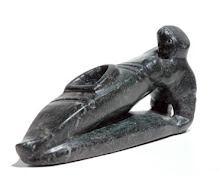
I admit that I mostly bought Adney & Chapelle's "Bark Canoes and Skin Boats of North America" because, besides the abundant material on canoes, it also dealt with kayaks and had lines for several kinds of them. I was not disappointed. Although it obviously wasn't the book's main focus, the comparatively short kayak section proved useful. I largely ignored the canoe parts of the book (that is, most of it) and it is only now that, as a sort of unexpected bonus, I am beginning to discover and enjoy the true extent of this book's value.
For example, as I haphazardly browse across it, I'm being repeatedly struck by the beauty and elegance of many traditional canoe paddles. These are objects that do not look like a shovel diverted to other uses in a pinch or a not terribly happy moment of inspiration. No. These things have finely carved, long, narrow blades that run into their shafts and hand grips along fluid lines. Very nice.

And, their good looks notwithstanding, they are tools first and foremost. These were the paddles used by Native American hunters, early explorers and the legendary Voyageurs, the crews of the mythical Maitre Canots and the Canots du Nord and on whose very ability to cover huge distances by canoe the fur trade was built. All of these peoples needed to do lots of paddling without injury nor excessive exhaustion and it seems they all tended to use paddles with long, narrow blades. Adney, recounting Voyageur practices is quite clear: "The Voyageur was particular about his paddle; no man in his right mind would use a blade wider than between 4 1/2 and 5 inches, for anything wider would exhaust him in a short distance."

And the interesting little discoveries go on (at least for me, canoe-ignorant that I am). When looking at the hand grips, many are obviously carved to be held not with the hand cupped over their top, but across them, with the forearm at a right angle to the shaft. Such design, apparently known as "Northwooods grip", or "Maine guide grip" allows for a variety of grips, providing versatility by being able to change paddle length as required. It is also conducive to the "Northwoods stroke", claimed in turn to be easier on wrists and forearms and to encourage applying power from torso rotation.

So, it would seem that in the canoe universe, recreational paddlers looking at traditional practices and gear are finding valuable stuff. Among other things, that long, narrow blades can work very well.
It sounds familiar...



No hay comentarios:
Publicar un comentario